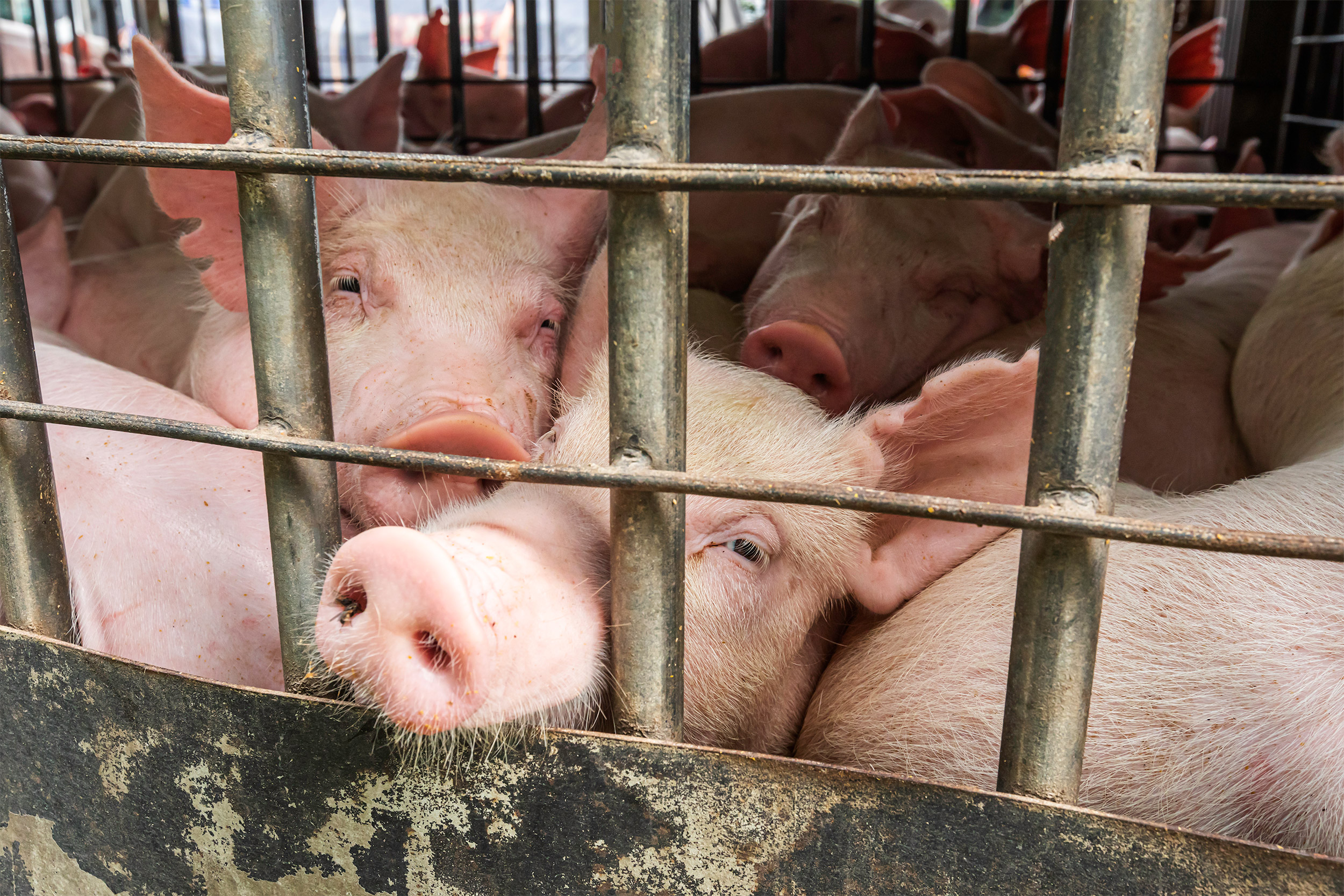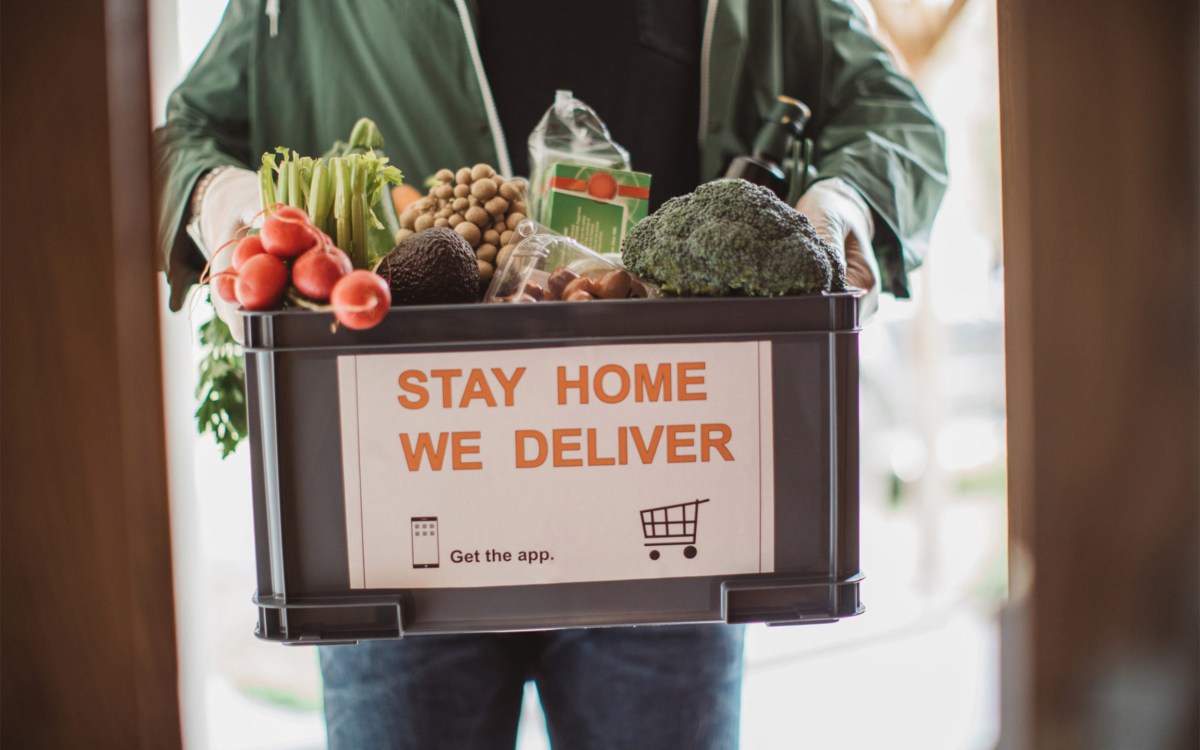
Researcher Ann Linder points out that the U.S. raises more pigs and poultry than almost anywhere in the world. Both species, she says, can act as carriers of influenza viruses, considered by experts as the most dangerous kind of virus.
iStock by Getty Images
COVID-19 came from animals. Why aren’t we working to prevent new scourge?
New research finds threat not just in foreign lands, live markets in U.S. enormous, largely unregulated
COVID-19 has killed 7 million people worldwide so far. The novel coronavirus that causes it is widely believed to have jumped from animals to humans at a market selling live animals in Wuhan, China, in late 2019. Now the results of a new study suggest we are as vulnerable as ever to the emergence of another such virus as deadly, or even more so.
In early July, researchers at Harvard Law School’s Brooks McCormick Jr. Animal Law and Policy Program and New York University’s Center for Environmental and Animal Protection released an in-depth examination of 36 animal markets in the U.S., spanning everything from livestock for food to the fur trade to niche markets like camel farming and bat guano harvesting. They found that the U.S. live animal trade is enormous and largely unregulated.
And where it is regulated, regulators are largely blind to public health concerns and the potential for zoonotic diseases, which cross from animals to humans. The research team was formed during the pandemic in 2020 with a goal of taking a close look at such markets in 15 countries to gauge the risk of activities that drive animal-to-human transmission of pathogens.
The Gazette spoke with the report’s lead author, Ann Linder, associate director of policy and research for the McCormick Program. Linder discussed the hidden dangers in the U.S. animal trade and what can be done to shore up the regulatory system. The interview was edited for length and clarity.
Q&A
Ann Linder
GAZETTE: Are we worried enough about zoonotic diseases?
LINDER: I don’t think so. These are really critical threats, but they’re not at the forefront of everyone’s minds, even after COVID. There’s a vast disparity in federal funding for public health and pandemic prevention versus something like military defense, even though both of those pose serious risks to human lives. There have been prior disease outbreaks that have killed more Americans than the World Wars combined, but we’re going to spend something like 1,500 times as much on defense as on pandemic preparedness in this fiscal year. We’re systematically undervaluing these threats, even after COVID.
GAZETTE: The report discusses how more emerging diseases occurred in the U.S. in the second half of the 20th century than anywhere else in the world. Do we view this as something that occurs in exotic locations elsewhere as opposed to here?
LINDER: That’s one of the fundamental misunderstandings that we’ve tried to expose and explain. Too often people think of this as an “over there” problem when we, in fact, use and consume more animals in the United States than almost anywhere else on Earth. Many of those human-animal interactions that can give rise to zoonotic disease are not properly regulated here any more than they are elsewhere.
GAZETTE: In the U.S. report, was there anything surprising to you?
LINDER: The diversity and scale of animal use in the United States was really startling. Even three years into this process, we were still coming across different forms of animal industry that we did not know existed. We are the largest importer of live wildlife in the world. We processed 10 billion land animals for consumption last year. We’re a huge player in this game, but I think most people would be surprised at how little regulation there is to protect public health in many of these animal industries. We have 36 industries in the report, but that’s by no means exhaustive.
GAZETTE: Are there particular factors that make a market more dangerous than another?
LINDER: We tried to come up with a discrete set of risk factors and use those consistently to analyze these markets. Overcrowding, sanitation, how closely humans and animals interact, how closely animals interact with members of the same species and with different species, what biosecurity looks like in those different industries, how long supply chains are, because the risk of disease can grow across a supply chain over time. We also looked at the scale of each of these industries. Do the animals have regular access to vet care? What sources are they coming from? Are they mixing with different animals along supply chains before they reach the consumer? And also, how much regulation is in place to mitigate risks?
“Too often people think of this as an ‘over there’ problem when we, in fact, use and consume more animals in the United States than almost anywhere else on Earth.”
GAZETTE: Is there a particular market or markets that you think are most worrisome?
LINDER: Three come to mind. We have to take industrial animal agriculture seriously because of its scale. It’s hard to describe how vastly disproportionate our use of food animals is compared to other uses. Plus, two species that we raise here in the United States in greater numbers than almost anywhere else in the world are pigs and poultry, and those species can act as carriers of influenza viruses. From the standpoint of a potential future human pandemic, every expert we spoke to agreed that influenzas are the most dangerous kind of virus.
Another industry that we need to look at very closely is the exotic pet trade. We’re moving millions of live wild animals into the United States and often those animals are very poorly tracked. We don’t have very much information about their health status, and yet they’re going to live in our homes as pets and interact closely with average Americans. They might be carrying diseases that our medical system is ill equipped to diagnose and treat because they’re not typically seen here. Mpox virus first came to the U.S. in one of these shipments of live wildlife. Yet, there is so little data about this industry that when we tried to get an estimate of the number of animals involved in the exotic pet trade, assessments varied by tens of millions.
The last one is fur farming. In fur farming, you have high-risk species of wildlife like mink, which were infected with COVID and created new forms of the virus that spread back to people, and you raise them in high-risk conditions, ones that we might expect on a factory farm, where animals are held in close proximity, and there’s a lot of opportunity for disease to spread.
Mink on fur farms also can carry influenza viruses, which are very dangerous. On top of that, fur farming is one of the least regulated of all the industries we looked at because it falls into a regulatory void: These animals are not quite livestock, so the livestock authorities don’t deal with them, and they’re also not free-roaming wildlife, so they’re not regulated in that way either.
GAZETTE: I would imagine there is a lot of attention at least on industrial agriculture. Are there gaps in what we do there?
LINDER: There are significant gaps. Most of the regulation concerning public health and livestock production happens at and after the point of slaughter. The USDA, for example, does not regulate on-farm production activities. But if a disease spills over to a consumer who eats the meat after slaughter, or earlier, to a livestock worker in a facility before slaughter, in both cases, these are communicable diseases that can spread person to person and erupt into a large-scale outbreak.
Estimates suggest that more than 20 million animals arrive dead at slaughterhouses each year. We don’t know what those animals are dying from, whether it’s heat exhaustion, dehydration, or disease. Once they arrive, you might have individual animals that are excluded from production if they’re exhibiting signs of disease, but they’ve just been transported to that facility on a truck with hundreds or thousands of other animals, exposing those animals as well.
GAZETTE: What should we do?
LINDER: A lot. Our big-picture takeaway is that we don’t have a comprehensive regulatory scheme to address these risks. Our response is reactive, too often waiting until after an outbreak rather than proactively regulating species that we know carry these diseases. We’re not communicating information well between different regulatory agencies. There are wide gaps in jurisdiction, and things fall between the cracks. Pathogens can jump from livestock to wildlife to humans, but the agencies tasked with managing each of those subjects aren’t communicating with each other.
We need a unifying, comprehensive scheme that can knit together these gaps and a guiding public health mandate that governs these industries and guides these agencies. One point I want people to take away is that we need to focus on prevention. Some of these pathogens are so contagious, you can’t afford to wait until an outbreak happens to mount a response. We have a good understanding of how diseases move from animals to humans, but the more interesting and important question is, what are we going to do about it? Do we have the willpower to do something before we’re forced to by something like COVID?






